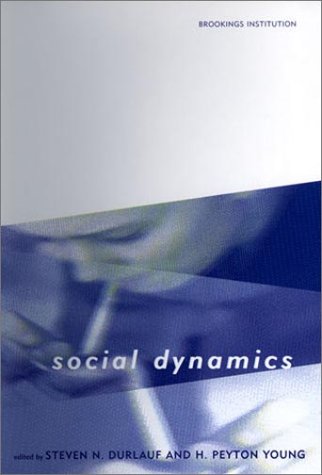Reviewed by
Michael Makowsky
Department of Economics, George Mason University

Economics, perhaps more than any of its sister social sciences, is a discipline defined by its methodology rather than its subject matter. As such, the evolution and advancement of underlying philosophies of practice are of paramount importance. The independently authored chapters of Social Dynamics create a coherent map of recent punctuated advancements in the socialisation of economic methodology and theory.
Neither overwhelming mathematical, nor lacking concrete technical and quantitative detail, Social Dynamics will serve those interested in the foundations of what the editors refer to as "The New Social Economics." The dual importance of direct and indirect interaction of individual agents acts as the common thread in the series of models and analyses presented. Many of the arguments put forth in favour of this progressive socialisation will already be familiar to readers with a background in non-economic social sciences and multi-agent social modelling, as they will to many students of evolutionary and Austrian economics, but what is not original in thought is largely original in co-assembly. It should be stressed that this is largely not a book about multi-agent simulation modelling, but rather a collection of the technical theory and tools that such models, particularly economic ones, should be based on.
Practitioners of agent-based computational and simulation modelling will be interested by the extensive treatment of the difficulties of heterogeneity, endogenous group membership and simultaneity encountered by traditional methodologies when taking on socially interactive phenomena. More than just acknowledging them, the clever means by which such problems have been dealt with are elucidated. In this regard, the econometric methods explained by Edward Glaeser and José Scheinkman, and the mathematics of Lawrence Blume and Steven Durlauf are enlightening. Modellers practicing without this work in mind are operating at a disadvantage.
The broad philosophical concerns of an increasingly socialised economics are explored by the editors, but also considered in the more specialised contributions of Samuel Bowles and Ken Binmore. (Such verbal excursions are extremely welcome as social economics becomes an increasingly esoteric field, requiring technical knowledge of programming and mathematics, if not economics.) There is always an undercurrent of concern when the discussion turns to increasing the endogenised complexity of the rational actor homo economicus. While opening this Pandora's Box may not bode well for the traditional comparative static models of the past, the arguments presented in Social Dynamics suggest that the modelling of previously exogenous features of the rational actor, such as preferences, would contribute significantly to the field.
While the book is more accessible to those with economic training, it still has value for the general social scientist. In particular, those with a policy slant to their work will find the various analyses of policy recommendations and pathologies interesting. The potential that socially interactive theories have to offer an increasingly multidimensional evaluation of policy relevance and complementarities is discussed.
Agent-based modellers will be interested in the chapter by Axtell, Epstein and Young. Their model is a classic example of the potential for relatively simple theories to demonstrate broad implications when populated with heterogeneous agents. Beyond the interesting subject matter, modellers stand to learn from the extremely clever visual representation of this model as well. Many authors have previously found themselves stumped by the problem of presenting a dynamic model on paper.
Social Dynamics is intended as a synthesis of research with a common methodological goal. That said, it does not profess to have the definitive answers to difficult methodological questions. The authors of the various chapters are to be commended for clearly outlining the difficulties in existing theories of populations with interactive agents. These difficulties have done much to create demand for new tools that social scientists can use. It will no doubt prove to be a mark of wisdom choosing correctly which theories to build on and which to build beyond. Social Dynamics represents a solid collection for those seeking to acquire such wisdom.
Return to Contents
of this issue
© Copyright Journal of Artificial Societies and Social Simulation, 2005